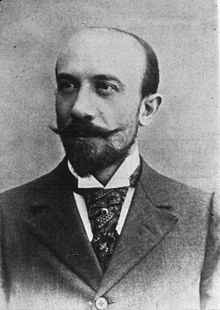Georges Méliès (partially found silent films from French director; 1890s-1910s): Difference between revisions
No edit summary |
(Added Lost box, fixed grammar and formatting, added references) |
||
| Line 1: | Line 1: | ||
{{InfoboxLost | |||
|title=<center>George Melies' Filmography</center> | |||
|image=George_Melies.jpg | |||
|imagecaption=Filmmaker George Melies. | |||
|status=<span style="color:red;">'''Partially Lost'''</span> | |||
}} | |||
''' | '''''NOTE:''' Because of this man's absolutely massive filmography, any information on his missing films should be put here. Nearly half of his 500+ films are still missing, many with very minimal information. This is to prevent hundreds of articles on his films, many of which would be very short and lacking information.''<ref>[https://en.wikipedia.org/wiki/Georges_M%C3%A9li%C3%A8s_filmography Melies' filmography, including the status of each of his films.] Retrieved 19 Mar '16.</ref> | ||
Melies | '''George Melies''' is often cited the "First Magician of Cinema".<ref>[https://en.wikipedia.org/wiki/Georges_M%C3%A9li%C3%A8s Wikipedia article.] Retrieved 19 Mar '16. </ref> Starting out his career as a stage magician, he was introduced to film by its French inventors during a tour. He invested his time and money into constructing a film studio. After some initial financial struggles, he went on to become one of the most successful and influential filmmakers of his time. | ||
Melies | Melies was most well-known for his innovations in special effects. His films often have a very surreal, dreamlike feel to them. Other filmmakers of his time used special effects that look dated by today's standards, but Melies films have aged far better. | ||
Of the over 500 Melies films | Melies slowly fell out of popularity by World War I, as audiences became disillusioned of his dreamlike visions, and George went bankrupt. He had to shut down his business and destroy most of his master negatives in order to sell the silver contained in the film to pay off his debts. It wouldn't be until close to Melies' death that his films would be recognized for their historical importance. | ||
Of the over 500 Melies films created (and documented) a total of only 231 exist today. His films are some of the most commonly sought-after lost films of his era. Some films exist only in their black-and-white versions with many of his colorized versions (which were hand-tinted frame by frame) still missing. | |||
Among the most recent films discovered was a colorized copy of his most treasured film ''A Trip to the Moon''. It was found in an abandoned barn after having survived harsh weather conditions. | |||
==Recovered Footage== | |||
{{#ev:youtube|https://www.youtube.com/watch?v=lUAD4lKNDI8|640x480|center|The long thought lost color version of Melies' renowned film, A Trip to the Moon.|frame}} | |||
==References== | |||
<references/> | |||
[[Category:Lost films]] | [[Category:Lost films]] | ||
Revision as of 04:58, 19 March 2016
NOTE: Because of this man's absolutely massive filmography, any information on his missing films should be put here. Nearly half of his 500+ films are still missing, many with very minimal information. This is to prevent hundreds of articles on his films, many of which would be very short and lacking information.[1]
George Melies is often cited the "First Magician of Cinema".[2] Starting out his career as a stage magician, he was introduced to film by its French inventors during a tour. He invested his time and money into constructing a film studio. After some initial financial struggles, he went on to become one of the most successful and influential filmmakers of his time.
Melies was most well-known for his innovations in special effects. His films often have a very surreal, dreamlike feel to them. Other filmmakers of his time used special effects that look dated by today's standards, but Melies films have aged far better.
Melies slowly fell out of popularity by World War I, as audiences became disillusioned of his dreamlike visions, and George went bankrupt. He had to shut down his business and destroy most of his master negatives in order to sell the silver contained in the film to pay off his debts. It wouldn't be until close to Melies' death that his films would be recognized for their historical importance.
Of the over 500 Melies films created (and documented) a total of only 231 exist today. His films are some of the most commonly sought-after lost films of his era. Some films exist only in their black-and-white versions with many of his colorized versions (which were hand-tinted frame by frame) still missing.
Among the most recent films discovered was a colorized copy of his most treasured film A Trip to the Moon. It was found in an abandoned barn after having survived harsh weather conditions.
Recovered Footage
References
- ↑ Melies' filmography, including the status of each of his films. Retrieved 19 Mar '16.
- ↑ Wikipedia article. Retrieved 19 Mar '16.
